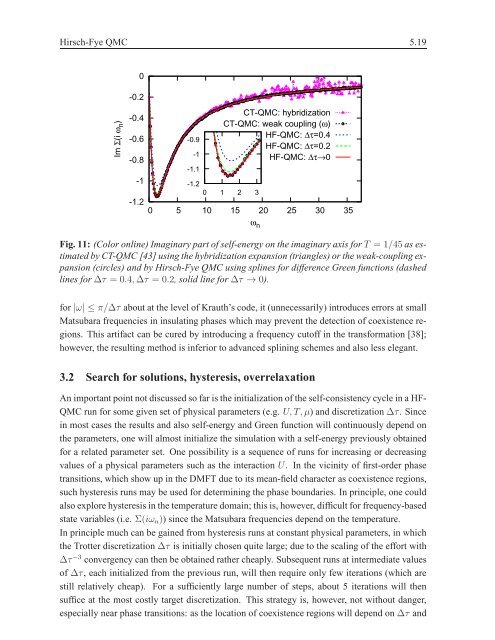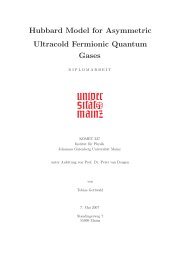5 Hirsch-Fye quantum Monte Carlo method for ... - komet 337
5 Hirsch-Fye quantum Monte Carlo method for ... - komet 337
5 Hirsch-Fye quantum Monte Carlo method for ... - komet 337
You also want an ePaper? Increase the reach of your titles
YUMPU automatically turns print PDFs into web optimized ePapers that Google loves.
<strong>Hirsch</strong>-<strong>Fye</strong> QMC 5.19<br />
Im Σ(i ω n )<br />
0<br />
-0.2<br />
-0.4<br />
-0.6<br />
-0.8<br />
-1<br />
-1.2<br />
-0.9<br />
-1<br />
-1.1<br />
CT-QMC: hybridization<br />
CT-QMC: weak coupling (ω)<br />
HF-QMC: ∆τ=0.4<br />
HF-QMC: ∆τ=0.2<br />
HF-QMC: ∆τ→0<br />
-1.2<br />
0 1 2 3<br />
0 5 10 15 20 25 30 35<br />
Fig. 11: (Color online) Imaginary part of self-energy on the imaginary axis <strong>for</strong>T = 1/45 as estimated<br />
by CT-QMC [43] using the hybridization expansion (triangles) or the weak-coupling expansion<br />
(circles) and by <strong>Hirsch</strong>-<strong>Fye</strong> QMC using splines <strong>for</strong> difference Green functions (dashed<br />
lines <strong>for</strong>∆τ = 0.4,∆τ = 0.2, solid line <strong>for</strong>∆τ → 0).<br />
<strong>for</strong>|ω| ≤ π/∆τ about at the level of Krauth’s code, it (unnecessarily) introduces errors at small<br />
Matsubara frequencies in insulating phases which may prevent the detection of coexistence regions.<br />
This artifact can be cured by introducing a frequency cutoff in the trans<strong>for</strong>mation [38];<br />
however, the resulting <strong>method</strong> is inferior to advanced splining schemes and also less elegant.<br />
3.2 Search <strong>for</strong> solutions, hysteresis, overrelaxation<br />
An important point not discussed so far is the initialization of the self-consistency cycle in a HF-<br />
QMC run <strong>for</strong> some given set of physical parameters (e.g. U,T,µ) and discretization∆τ. Since<br />
in most cases the results and also self-energy and Green function will continuously depend on<br />
the parameters, one will almost initialize the simulation with a self-energy previously obtained<br />
<strong>for</strong> a related parameter set. One possibility is a sequence of runs <strong>for</strong> increasing or decreasing<br />
values of a physical parameters such as the interaction U. In the vicinity of first-order phase<br />
transitions, which show up in the DMFT due to its mean-field character as coexistence regions,<br />
such hysteresis runs may be used <strong>for</strong> determining the phase boundaries. In principle, one could<br />
also explore hysteresis in the temperature domain; this is, however, difficult <strong>for</strong> frequency-based<br />
state variables (i.e. Σ(iωn)) since the Matsubara frequencies depend on the temperature.<br />
In principle much can be gained from hysteresis runs at constant physical parameters, in which<br />
the Trotter discretization ∆τ is initially chosen quite large; due to the scaling of the ef<strong>for</strong>t with<br />
∆τ −3 convergency can then be obtained rather cheaply. Subsequent runs at intermediate values<br />
of ∆τ, each initialized from the previous run, will then require only few iterations (which are<br />
still relatively cheap). For a sufficiently large number of steps, about 5 iterations will then<br />
suffice at the most costly target discretization. This strategy is, however, not without danger,<br />
especially near phase transitions: as the location of coexistence regions will depend on∆τ and<br />
ω n













